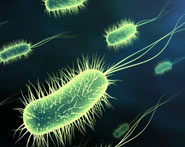


 النبات
النبات
 الحيوان
الحيوان
 الأحياء المجهرية
الأحياء المجهرية
 علم الأمراض
علم الأمراض
 التقانة الإحيائية
التقانة الإحيائية
 التقنية الحيوية المكروبية
التقنية الحيوية المكروبية
 التقنية الحياتية النانوية
التقنية الحياتية النانوية
 علم الأجنة
علم الأجنة
 الأحياء الجزيئي
الأحياء الجزيئي
 علم وظائف الأعضاء
علم وظائف الأعضاء
 الغدد
الغدد
 المضادات الحيوية
المضادات الحيوية|
Read More
Date: 24-11-2021
Date: 24-9-2021
Date: 28-12-2021
|
Glycogenolysis
The degradative pathway that mobilizes stored glycogen in liver and skeletal muscle is not a reversal of the synthetic reactions. Instead, a separate set of cytosolic enzymes is required. When glycogen is degraded, the primary product is glucose 1-phosphate, obtained by breaking α(1→4) glycosidic bonds. In addition, free glucose is released from each α(1→6)–linked glucosyl residue (branch point).
A. Chain shortening
Glycogen phosphorylase sequentially cleaves the α(1→4) glycosidic bonds between the glucosyl residues at the nonreducing ends of the glycogen chains by simple phosphorolysis (producing glucose 1-phosphate) until four glucosyl units remain on each chain at a branch point (Fig. 1). The resulting structure is called a limit dextrin, and phosphorylase cannot degrade it any further . [Note: Phosphorylase requires pyridoxal phosphate (a derivative of vitamin B6) as a coenzyme.]
Figure 1: Cleavage of an α(1→4)-glycosidic bond. PLP = pyridoxal phosphate; Pi = inorganic phosphate; = phosphate.
B. Branch removal
Branches are removed by the two enzymic activities of a single bifunctional protein, the debranching enzyme . First, oligo-α(1→4)→α(1→4)-glucantransferase activity removes the outer three of the four glucosyl residues remaining at a branch. It next transfers them to the nonreducing end of another chain, lengthening it accordingly. Thus, an α(1→4) bond is broken and an α(1→4) bond is made, and the enzyme functions as a 4:4 transferase. Next, the remaining glucose residue attached in an α(1→6) linkage is removed hydrolytically by amylo-α(1→6)-glucosidase activity, releasing free (nonphosphorylated) glucose. The glucosyl chain is now available again for degradation by glycogen phosphorylase until four glucosyl units in the next branch are reached.
C. Glucose 1-phosphate isomerization to glucose 6-phosphate
Glucose 1-phosphate, produced by glycogen phosphorylase, is isomerized in the cytosol to glucose 6-phosphate by phosphoglucomutase . In the liver, glucose 6-phosphate is transported into the endoplasmic reticulum (ER) by glucose 6-phosphate translocase. There, it is dephosphorylated to glucose by glucose 6-phosphatase (the same enzyme used in the last step of gluconeogenesis). The glucose is then transported from the ER to the cytosol. Hepatocytes release glycogenderived glucose into the blood to help maintain blood glucose levels until the gluconeogenic pathway is actively producing glucose. [Note: Muscle lacks glucose 6-phosphatase. Consequently, glucose 6-phosphate cannot be dephosphorylated and sent into the blood. Instead, it enters glycolysis, providing energy needed for muscle contraction.]
D. Lysosomal degradation
A small amount (1%–3%) of glycogen is degraded by the lysosomal enzyme, acid α(1→4)-glucosidase (acid maltase). The purpose of this autophagic pathway is unknown. However, a deficiency of this enzyme causes accumulation of glycogen in vacuoles in the lysosomes, resulting in the serious GSD type II: Pompe disease . [Note: Pompe disease is the only GSD that is a lysosomal storage disease.]
Lysosomal storage diseases are genetic disorders characterized by the accumulation of abnormal amounts of carbohydrates or lipids primarily due to their decreased lysosomal degradation resulting from decreased activity or amount of lysosomal acid hydrolases.



|
|
|
|
دخلت غرفة فنسيت ماذا تريد من داخلها.. خبير يفسر الحالة
|
|
|
|
|
|
|
ثورة طبية.. ابتكار أصغر جهاز لتنظيم ضربات القلب في العالم
|
|
|
|
|
|
|
سماحة السيد الصافي يؤكد ضرورة تعريف المجتمعات بأهمية مبادئ أهل البيت (عليهم السلام) في إيجاد حلول للمشاكل الاجتماعية
|
|
|